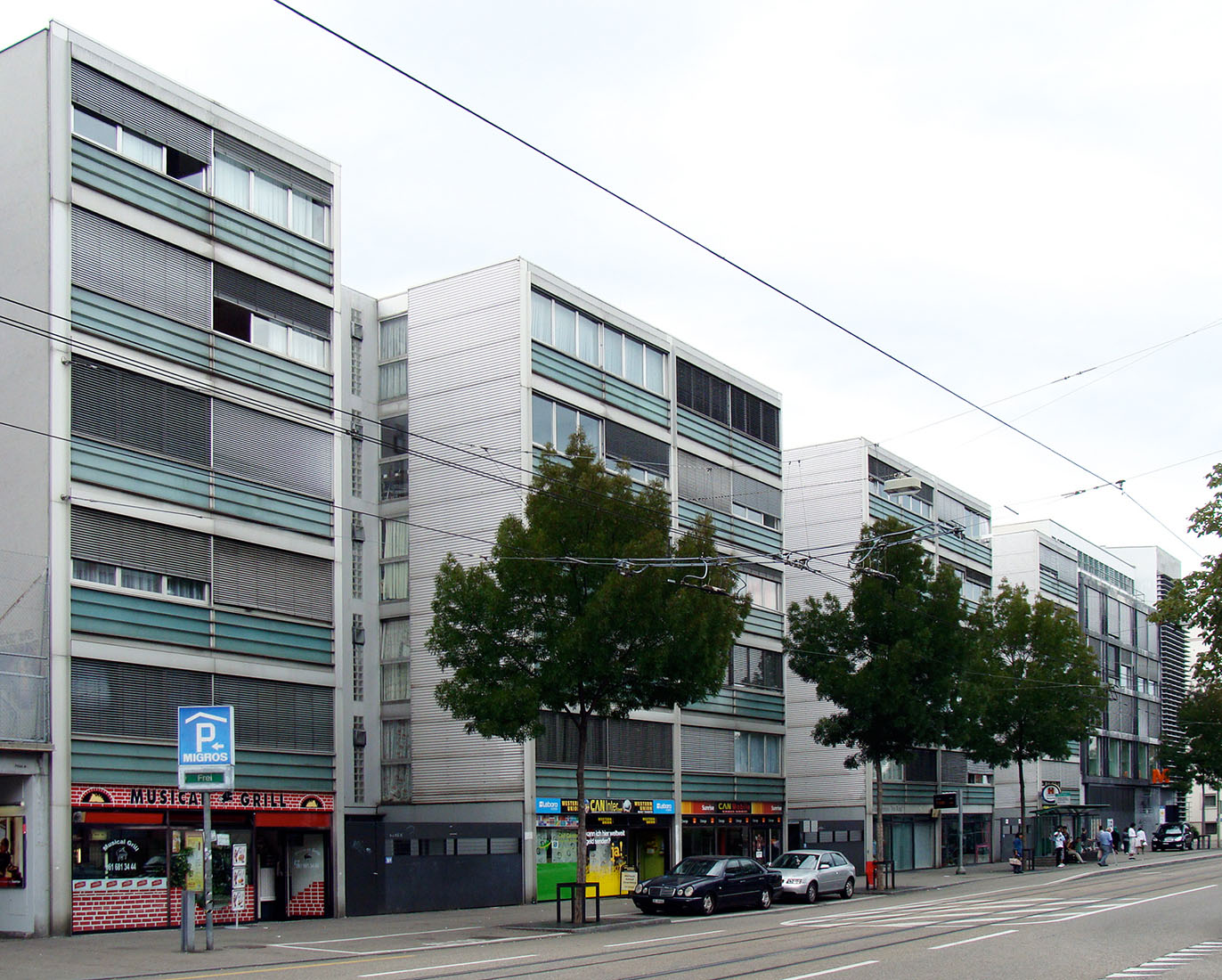 |
 |
 |
 |

Apartment Buildings Riehenring, Basel
Riehenring 169-175 / Efringerstr. 22-32
1980 - 1985
The
Riehenring project is based on a programm of subsidized housing, as it
is the case with several other apartment buildings in the immediate
neighbourhood.
The Hammerstrasse project, which was realized by Diener & Diener architects only a few years earlier, is to be found within a very short distance. The two projects
even are connected by a common feature. The tree-lined passage of the Hammerstrasse residential development, located on the adjacent bock, is continued as a
narrower path through the Riehenhring courtyard. The ground floor of the Riehenring project is occupied by retail and commercial spaces. These functions make
the building block a busy commercial and community centre during the whole day. The wide courtyard of the Riehenring developmentt serves as a recreational space for
the entire quarter, giving the Riehenring project an even more public character. This courtyard staged film events during the 1980s and 90s. For these events a projector
was mounted on the terrace and directed onto the walls of the older buildings to the south. As a counterbalance to the public character, the roof terraces of the apartment
buildings were designed as sun decks.
The large scale of the project is expessed in a changing articulation of the facades, which are also considered to be a response to the surrounding urban fabric.
Three building units are structured around inner courtyards along the busy Riehenring main street. The courtyard facades are clad with horizontally-mounted
corrugated metal. Continous lines of balconies emphasize the length of the building. The living rooms are placed along the street facade, wich comprises a frame
of concrete which is filled with glass and metal. Special attention was given to the corner situations. The Riehenring project contains primarily residential uses,
although it has the appearance of a commercial building. The upper floors of the project contain seventy-four apartments of various sizes and types. There are found
flats from two to five bedrooms, what allows for a diverse range of residents. All floor plans of the apartments follow the same logic. They consist of three permeable layers
and result in a middle zone for living and not only for circulation. As a special feature, the freestanding bathroom units paired with the diagonally-set open kitchen,
establish a spatial relationship between the entrance area and the generous street-facing living spaces. The daytime functions are not defined by separate rooms,
but by space-defining elements. This layout introduces a dynamism to the apartments.
The Hammerstrasse project, which was realized by Diener & Diener architects only a few years earlier, is to be found within a very short distance. The two projects
even are connected by a common feature. The tree-lined passage of the Hammerstrasse residential development, located on the adjacent bock, is continued as a
narrower path through the Riehenhring courtyard. The ground floor of the Riehenring project is occupied by retail and commercial spaces. These functions make
the building block a busy commercial and community centre during the whole day. The wide courtyard of the Riehenring developmentt serves as a recreational space for
the entire quarter, giving the Riehenring project an even more public character. This courtyard staged film events during the 1980s and 90s. For these events a projector
was mounted on the terrace and directed onto the walls of the older buildings to the south. As a counterbalance to the public character, the roof terraces of the apartment
buildings were designed as sun decks.
The large scale of the project is expessed in a changing articulation of the facades, which are also considered to be a response to the surrounding urban fabric.
Three building units are structured around inner courtyards along the busy Riehenring main street. The courtyard facades are clad with horizontally-mounted
corrugated metal. Continous lines of balconies emphasize the length of the building. The living rooms are placed along the street facade, wich comprises a frame
of concrete which is filled with glass and metal. Special attention was given to the corner situations. The Riehenring project contains primarily residential uses,
although it has the appearance of a commercial building. The upper floors of the project contain seventy-four apartments of various sizes and types. There are found
flats from two to five bedrooms, what allows for a diverse range of residents. All floor plans of the apartments follow the same logic. They consist of three permeable layers
and result in a middle zone for living and not only for circulation. As a special feature, the freestanding bathroom units paired with the diagonally-set open kitchen,
establish a spatial relationship between the entrance area and the generous street-facing living spaces. The daytime functions are not defined by separate rooms,
but by space-defining elements. This layout introduces a dynamism to the apartments.
